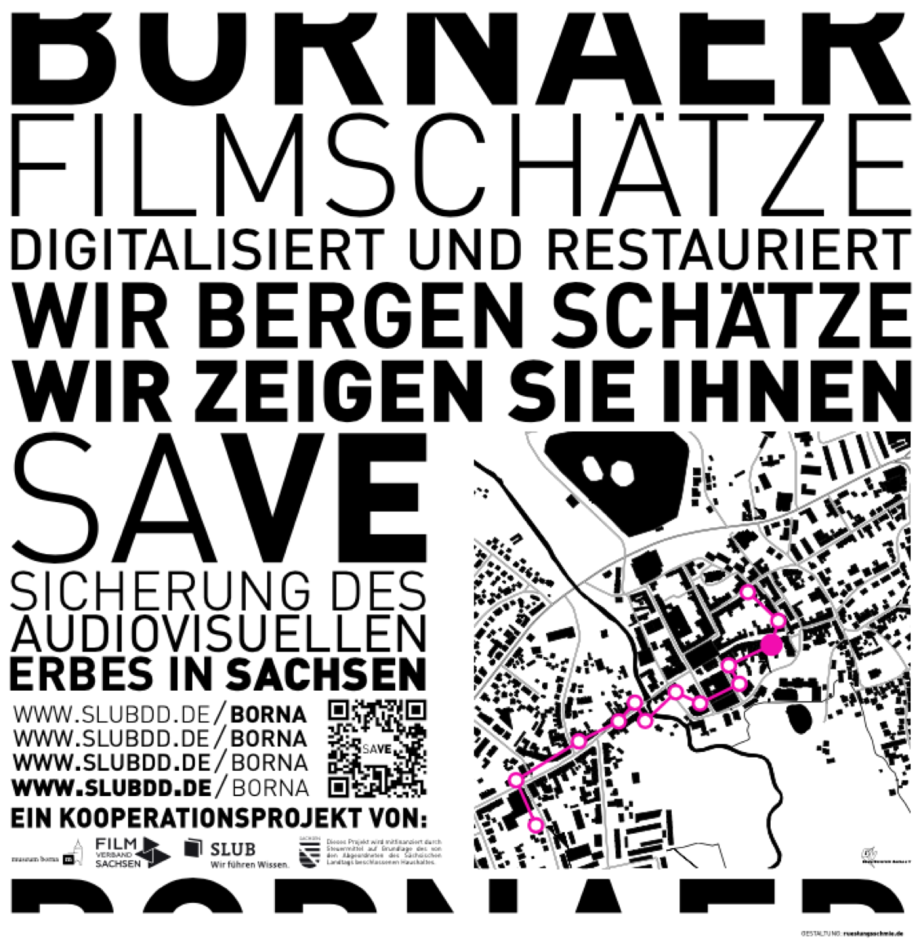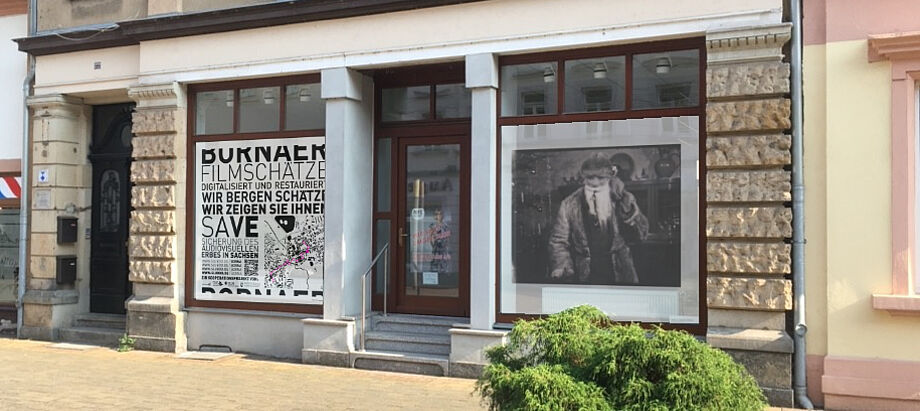Borna Film Promenade 2021/2022
Borna film treasures - digitised and restored


We recover treasures - and we show them to you! In cooperation with the Borna Museum, the Film Association of Saxony and the Borna Trade Association, the Saxon State Library - Dresden State and University Library is showing film clips from Borna sources at a dozen locations in Borna's city centre. As part of the state-funded SAVE programme ("Safeguarding the Audiovisual Heritage in Saxony"), they have been restored in recent years, some of them at great expense, digitised and are now publicly accessible via the media library of the SLUB Dresden.
But we would now also like to show you the films at the "scene of the action", in Borna itself. Look out for us: in the bookshop, in the perfumery, in the gift shop or at the master electrician's, there are screens in the shop window on which old film treasures flicker: from the pageant on the occasion of the town's 800th anniversary, but also little films "from the attic". The films reflect the life of Borna in their time and are part of the cultural memory of the Free State of Saxony. We would like to encourage you to donate your private film treasures to us! You can read more about the SAVE project here. And you will find more information about the individual film excerpts of the project below.
| "800 Years of Borna" | This film was produced in 1938 by the Film-Fabrik Helmut Krötel (Leipzig) on behalf of the town of Borna. Without reference to the town's history, an 800th anniversary celebration was planned for 1938. Shortly before the celebrations, it was only called "Heimatfest". The first thing to be seen is the preparatory work for the festival, which was held from 18 to 23 June 1938. This includes shots of the arrival of guests at the railway station, their escort through the town and the welcoming ceremony at the market. This is followed by events on individual theme days of the Heimatfest, e.g. Children's Day, Craft Day, Sports Day and Wehrmacht Day. A large part of the film is taken up by the parade, when individual pictures from the town's history are presented. This procession was the highlight of the festival with almost 3000 participants. The finale was the fireworks display at the Breiten Teich. The film shows valuable views of the town and its people, but from a clearly propagandistic perspective. In addition to the prevailing Nazi symbolism, the ideology of war and the militarisation of society play a central role. On the eve of the Second World War, the portrait links the tradition of the garrison town with Borna's current importance as the base of a Wehrmacht anti-tank detachment. Military and paramilitary marches and events by Nazi organisations form a central focus of the film. |
| "The Creating Borna" | This film was produced in 1938 by the Film-Fabrik Helmut Krötel (Leipzig) on behalf of the town of Borna. Presumably this film was to be shown together with the film "800 Years of Borna". It presents all the well-known companies and traders in Borna at the time, including the Rinck steam sawmill, the Reiche printing works (Bornaer Tageblatt) and the Rother brewery in Old Town Borna. The film is a very valuable documentary testimony due to its density of insights into economic and commercial life, including food retailing, in a medium-sized town. However, behind the brief highlights there are also untold stories - for example, the film stages a joyful procession of the administrative staff of the Borna branch of Deutsche Erdöl AG, which, as a company, had excluded Jewish members from its board of directors and supervisory board in 1937/1938 for anti-Semitic reasons. The source material for the digitisation of the film was a mute, black-and-white 35mm nitro-positive print from the holdings of the Museum of the City of Borna. The two film reels showed severe decomposition damage, so that partial sections of the film material that were not yet "caked" had to be manually separated and later partially digitally retouched. The original film length could not be verified. Compared to a preserved video scan made from the undamaged film in 1995, 177 film metres (6:27 min) are probably missing. |
| Confectionery and concert coffee house Robert Haussmann | This viragraphed film was made in 1926 as an advertisement for the Haussmann café and confectionery in Bahnhofstraße Borna. The daughter, Käte Brand, of the last owner (Erich Haussmann) wrote in a letter about it in 1998: "The "voluminous" 35mm film reel enclosed with this letter was used for cinema advertising. I suspect that the film dates from the early thirties. The ice-cream vans of that time drive out of our gateway, you can see shop window decorations, concert garden life (with the trio Bummer, Peterlein, Steinbach, later Fanny Müller-Schmidt sang and made music there), our special "products" (the "onion") had an almost naturally coloured skin, in the film it "comes out" too dark in my opinion), also the "onion".My grandfather Robert Haußmann opened and ran a "confectionery, café and restaurant" in the building "Zum Schweizerhaus" (today: Volkshaus) on 5 October 1891. His father Johann Gottlob Haußmann then bought the property at Lobstädter Straße 105 (now Bahnhofstr. 33). In May 1894, construction began on the property. The building was completed as early as October 1894. The construction manager was architect Rust from Leipzig, and the construction work was carried out by Wangemann and master carpenter Eichler, both from Borna. On the ground floor of this residential and commercial building, the "confectionery and coffee house trade and the serving of Bavarian beer were operated". In the course of time, the name changed, mainly in connection with alterations, renovations and new furnishings: 1901 Conditorei und Wiener Café, 1904 Wiener Café, 1913 Conditorei und Café R. Haußmann, 12/13 June 1924 First Borna Concert Café, 1928 after installation of the glass dance floors in 4-colour lighting, 1930 saw the installation of the same glass dance floor in the concert garden. Thursdays and Sundays were concert days. The concerts and dances were always very well attended. In February 1936, my father Erich Haußmann took over the business. The "Bornaer Zwiebel" (Borna onion), which had been produced since 1906, and also the "Bornaer Salonbrikett" (Borna saloon briquette), which was still known at that time, were sent out of town in "original boxes" from 1912/13 onwards, the onion at the same time with a picture postcard of Borna." |
| "Albert" (Albert in the car, at Christmas, sledging). | These films were made in 1955 by Helmut Schmidt, a local hero from Borna and world champion in peaceful fishing. They were made available to us by the Borna Museum. |
| "My Film Diary 1935 | This film diary of the Dresden ENT doctor Gerhard Schneider was made available to the library by the Dresden cameraman and film collector Ernst Hirsch. It covers the period from the beginning of the year to Christmas 1935. In it, the amateur filmmaker documents events from his private life. These include excursions with family and friends in the vicinity of Dresden, a trip to Lugano as well as footage from everyday life. In Borna, we will of course be showing the contemplative clips "under the Christmas tree" at Christmas time. |
You can admire our film treasures at the following locations (here is an overview map from Google Maps):
Goedels Erbgemeinschaft | Reichsstr. 22 |
The Insurance Company | Roßmarktsche Str. 15 |
Concordia Insurance | An der Mauer 7-9 |
Otto Leather Goods | Bahnhofstr. 12 |
Perfumery Funcke | Bahnhofstr. 7 |
Moments of happiness | Bahnhofstr. 5 |
Bookshop | Mühlgasse 5 |
Fashion Express No. 1 | Wassergasse 6 |
Market 15 | Market 15 |
Elektro Schreiter | Bahnhofstr. 32 |
LVZ | Brauhausstr. 3 |
Electrician Teichmann | Kantstr. 2 |